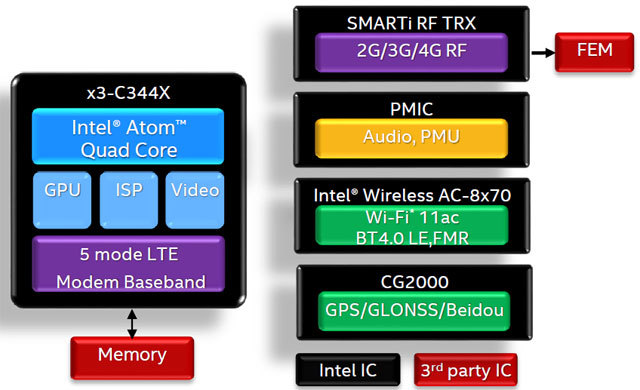Atom X. Intel's New Atomic Index

One of the main events of the IDF forum held in April was the presentation of a specialized SoC for phones and tablets Atom X (code name SoFIA). In general, over the past 2-3 years, we have witnessed the emergence of several new lines of Intel processors. And this is easily explained: the number of intelligent devices of various kinds is growing literally every day. These devices are so different in size and functionality that you can’t get by with one universal solution. Specialization, on the contrary, turns out to be more convenient than ever, due to it it is possible to create chips with optimal characteristics for a particular case. What is the specific telephone managed to cram into a new Atom?
If you answer the question above in one line, then it would be like this: Atom X is the first Intel SoC with integrated wireless modems (3G, 4G or Wi-Fi). But we are not going to limit ourselves to one line, so let's start in order. Moreover, the modem list of innovations, of course, is not exhausted.
The Intel Atom X line, by analogy with other well-known families of Intel processors, will consist of three parts: x3, x5 and x7. Of these, three wireless 3G / 4G modems will be available on the crystal only at x3, its purpose is phones, phablets and low-cost tablets. X5 processors will be offered with an integrated Wi-Fi adapter. The top x7 models are devoid of any communication interfaces, but they have maximum performance, they are designed for powerful tablets and in the general line of Intel are close to the Core M processors.
')
To date, three models of Atom x3 processors have been announced: a dual-core Atom x3-C3130 with a 3G modem, a quad-core Atom x3-C323xRK with a 3G modem, and a quad-core Atom x3-C344x with LTE. All processors are made on 28-nm process technology and have an x64 architecture. Their detailed characteristics are shown in the table.
| Intel Atom x3-C3130 (3G) | Intel Atom x3-C323XRK (3G) | Intel Atom x3-C344X (LTE) | |
|---|---|---|---|
| CPU | 2 cores up to 1.0 GHz | 4 cores up to 1.2 GHz | 4 cores up to 1.4 GHz |
| Graphics | Mali * 400 MP2 OpenGL * ES 2.0 | Mali 450 MP4 OpenGL ES2.0 | Mali T720 MP2 OpenGL ES3.0 & DirectX9.3, OpenCL * |
| Memory | 1x32 LPDDR2 800 | 1x32 LPDDR2 / 3 1066, DDR3 / DDR3L 2x16 1333 | 1x32 LPDDR2 / 3 1066 |
| Display resolution | 1280x800 @ 60fps | Up to 1920x 1080 @ 60fps | 1280x800 @ 60 fps1920x1080> 30 fps |
| Integrated modem | GSM / GPRS / EDGE, HSPA + 21/5. 8, DSDS, eDvP | GSM / GPRS / EDGE DC-HSPA + 42/11, TD-SCDMA FDD / TDD LTE Cat4 - Cat 6 | |
| Interfaces | Wi-Fi * 802.11bgn, Bluetooth 4.0 LE, GPS & GLONASS, FM Radio | Wi-Fi * 802.11ac, BT4.1 LE, GPS, GLONASS & Beidou, FM Radio NFC (optional) | |
| Enter exit | UART / SPI, I2C, I2S, SDIO | ||
| Camera (front / rear) | 13 megapixel / 5 megapixel | ||
For clarity, we present the architectural scheme of the older of the presented processor models, Intel Atom x3-C344X. "GLONSS" is GLONASS, naturally.

So, a start. The first to appear is the reference design for the model C3130, more precisely, one might say, it has already appeared. It will be followed next, in the second and third quarter of this year, respectively.
For those who like to dig deeper than publicly available advertising materials, we have posted a photo of the Atom X Hardware Development Kit for the KDPV, which is used to test the software for a new platform without having a ready device. For even more curious, let us sign its components.

Thus, the movement towards Intel's SoC-isation of processors continues, more and more new components are being taken on board (that is, on a chip). As mentioned at the beginning, the consumer only benefits from this, but how good the new “atoms” are, we will definitely demonstrate in our blog.
Source: https://habr.com/ru/post/256723/
All Articles